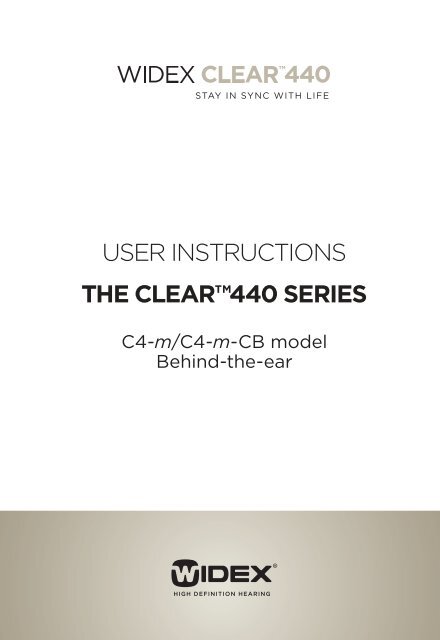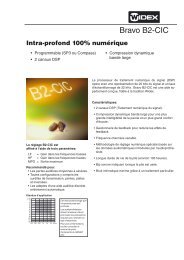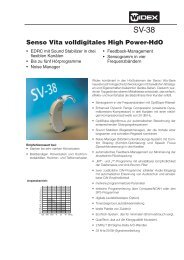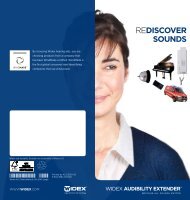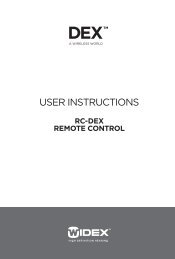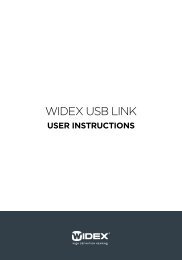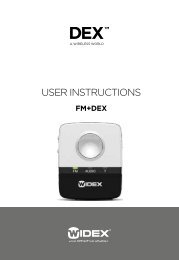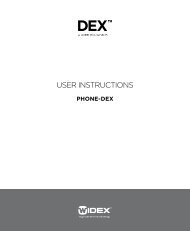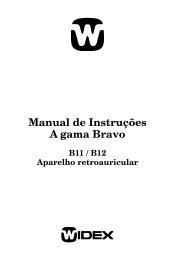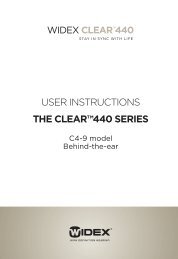Users instructions C4-m - Widex for professionals
Users instructions C4-m - Widex for professionals
Users instructions C4-m - Widex for professionals
You also want an ePaper? Increase the reach of your titles
YUMPU automatically turns print PDFs into web optimized ePapers that Google loves.
USER INSTRUCTIONSTHE CLEAR440 SERIES<strong>C4</strong>-m/<strong>C4</strong>-m-CB modelBehind-the-ear
YOUR WIDEX CLEAR440HEARING AID(To be filled out by the hearing care professional)Date: ___________________________________Battery size: ______________________________2
CONTENTSSYMBOLS. . . . . . . . . . . . . . . . . . . . . . . . . . . . . . . . . . . . . . . . 4THE HEARING AID . . . . . . . . . . . . . . . . . . . . . . . . . . . . . . . . 5Right/left identification. . . . . . . . . . . . . . . . . . . . . . . . . . . . . . 8Acoustic indicators. . . . . . . . . . . . . . . . . . . . . . . . . . . . . . . . . . 8The battery . . . . . . . . . . . . . . . . . . . . . . . . . . . . . . . . . . . . . . . . 9Inserting the battery . . . . . . . . . . . . . . . . . . . . . . . . . . . . . . 9Removing the battery . . . . . . . . . . . . . . . . . . . . . . . . . . . . 11Battery drawer without a nail grip . . . . . . . . . . . . . . . . . 12Low battery indication . . . . . . . . . . . . . . . . . . . . . . . . . . . 13Turning the hearing aid on and off . . . . . . . . . . . . . . . . . . . 14Positioning the hearing aid. . . . . . . . . . . . . . . . . . . . . . . . . . 15Removing the hearing aid . . . . . . . . . . . . . . . . . . . . . . . . . . 16Volume adjustment . . . . . . . . . . . . . . . . . . . . . . . . . . . . . . . . 17Lost partner alarm . . . . . . . . . . . . . . . . . . . . . . . . . . . . . . . . . 18Listening programs . . . . . . . . . . . . . . . . . . . . . . . . . . . . . . . . 18Switching between the listening programs. . . . . . . . . . 21Zen+ . . . . . . . . . . . . . . . . . . . . . . . . . . . . . . . . . . . . . . . . . . . 21Using a telephone. . . . . . . . . . . . . . . . . . . . . . . . . . . . . . . . . . 22CLEANING. . . . . . . . . . . . . . . . . . . . . . . . . . . . . . . . . . . . . . 23The hearing aid . . . . . . . . . . . . . . . . . . . . . . . . . . . . . . . . . . . . 24The microphone openings . . . . . . . . . . . . . . . . . . . . . . . . 24ACCESSORIES. . . . . . . . . . . . . . . . . . . . . . . . . . . . . . . . . . . 25IN CASE OF MALFUNCTION . . . . . . . . . . . . . . . . . . . . . . . 26CARING FOR YOUR HEARING AID. . . . . . . . . . . . . . . . . . 28WARNINGS . . . . . . . . . . . . . . . . . . . . . . . . . . . . . . . . . . . . . 29ADVICE . . . . . . . . . . . . . . . . . . . . . . . . . . . . . . . . . . . . . . . . 33REGULATORY INFORMATION. . . . . . . . . . . . . . . . . . . . . . 343
SYMBOLSThe following symbols will be used throughout themanual:WARNINGMessages with this heading indicate serious adverse reactions,potential safety hazards and inadequate per<strong>for</strong>mance of device.CAUTIONMessages with this heading indicate/include in<strong>for</strong>mation regardingany special care to be exercised.Not <strong>for</strong> general waste.4
THE HEARING AIDThe illustration below shows the hearing aid without anear-set. The choice of ear-set solution depends on yourspecific needs. Please refer to the separate ear-set usermanual.1. Microphone openings2. On/off function3. Nail grip4. LED/RL ID5
NOTEIn addition to these user <strong>instructions</strong>, a separate user manual isprovided describing the various ear-set solutions available <strong>for</strong>your hearing aid: “Ear-sets <strong>for</strong> <strong>Widex</strong> BTE hearing aids”WARNINGThis booklet and the manual “Ear-sets <strong>for</strong> <strong>Widex</strong> BTE hearingaids” contain important in<strong>for</strong>mation and <strong>instructions</strong>. Read thesebooklets carefully be<strong>for</strong>e you start using the hearing aid.NOTEYour hearing aid, ear-set and accessories may not look exactly asillustrated in this booklet. We also reserve the right to make anychanges considered necessary.Intended useThe CLEAR hearing aids are intended as air conductionamplification devices to be used in everyday listeningenvironments. The CLEAR hearing aids may be providedwith the Zen program intended to provide a relaxingsound background (i.e. music/noise source) <strong>for</strong> adultswho desire to listen to such a background in quiet.6
Indications <strong>for</strong> useThe devices are indicated <strong>for</strong> individuals with a range ofhearing loss severity from minimal (10 dB HL) to moderatelysevere (85 dB HL) and all hearing loss configurations.They are to be programmed by licensed hearing healthcare<strong>professionals</strong> (audiologists, hearing aid specialists,otolaryngologists) who are trained in hearing(re)habilitation as well as tinnitus management.Description of deviceYour CLEAR hearing aid is used with an ear-set whichconsists of a tube and an ear-tip or earmould. The hearingaid uses a proprietary wireless technology, <strong>Widex</strong>-Link, to enable communication between the left andthe right hearing aids, as well as between the hearingaids and the DEX accessories.Your hearing aid may be provided with a listening programcalled Zen. It makes musical tones (and sometimesa rushing noise) in the background. These soundsare shaped according to your hearing loss.7
Right/left identificationThe arrow shows the position of theidentification mark (red mark = rightand blue mark = left).Acoustic indicatorsThe hearing aid may be set to produce a signal to indicatethe use of certain functions. The signal may be aspoken message or tones adjusted by the hearing careprofessional in consultation with you. The signal canalso be deactivated.Adjusting volumevia remote controlTone*OffConfirming RC program key useClicking OffsoundChanging programMessage Tones Offvia remote controlStarting up the hearing aid Message Tone OffWarning about low battery Message 4 tones OffWarning about lost partner Message OffService reminder Message Off* Bold indicates standard setting8
The batteryWe recommend zinc-air batteries. Use a size 10 battery<strong>for</strong> the hearing aid.To obtain replacement batteries, please consult yourhearing care professional. It is important to take noteof the expiration date and the recommendations on thebattery pack regarding disposal of used batteries. Otherwisethere is a risk that the battery life may be reduced.Inserting the batteryBe<strong>for</strong>e inserting a new battery into thehearing aid, remember to remove the adhesivetab. Once the tab has been removed,the battery will start functioning after a fewseconds.CAUTIONDo not use batteries if there is a sticky residue from the tab orother unwanted substance, as this can cause the hearing aid tomalfunction.9
Use the nail grip to gently swing the battery draweropen. Do not press the drawer beyond the open position.Place the battery in the drawer as illustrated, so that theplus (+) sign on the battery is facing towards you whenyou hold the hearing aid as shown. You can use the batterymagnet provided to steer the battery into place.+If the battery drawer does not close easily, the batteryis incorrectly inserted.When changing battery, it is a good idea to hold thehearing aid over a table.10
Removing the battery1. Open the battery drawer as previously described.Place the hearing aid on the provided cloth on aclean, plane surface and turn it as illustrated.2. Supporting the drawer with your finger, use thebattery magnet provided to push the battery out ofthe battery drawer from the minus side.1. 2.11
Battery drawer without a nail gripThe hearing aid may be providedwith a battery drawer without a nailgrip, which means that you needa tool to open the battery drawer.This type of drawer can be a goodchoice if the hearing aid is worn bya child. A special tool <strong>for</strong> openingthe drawer will be included with thisdrawer.The battery drawer is opened as illustrated.12
Low battery indicationAn acoustic indicator will sound when the battery isnearly exhausted, unless this function has been disabled(see page 8). We recommend that you alwayshave a spare battery with you.WARNINGNever leave an exhausted battery in the hearing aid. Exhaustedbatteries may leak, damaging the hearing aid.WARNINGYour hearing aid may stop functioning, <strong>for</strong> instance if the batteryis exhausted. You should be aware of this possibility, in particularwhen you are in traffic or are otherwise dependent on warningsignals.13
Turning the hearing aid on and offThe battery drawer of the hearing aid also functions asthe on/off switch.Close the battery drawer to turn on thehearing aid. An acoustic indicator willindicate that the hearing aid has beenswitched on unless this function hasbeen disabled.Open the battery drawer to turn offthe hearing aid.Please remember to turn off the hearingaid when it is not in use. Removethe battery if the hearing aid will notbe used <strong>for</strong> several days.14
Positioning the hearing aidInsert the earpiece in the ear canal while holding thelower part of the tube. It may help to pull the outer earbackwards and upwards with the opposite hand.Place the hearing aid behind the ear, so that the hearingaid and tube rest com<strong>for</strong>tably on the ear, close toyour head.The illustrations show an open ear-tip. For further in<strong>for</strong>mationon ear-tip/earmould types, anchors and procedures,see the separate ear-set user manual provided.15
Removing the hearing aidRemove the hearing aid from its position behind theear.Carefully pull the earpiece out of the ear canal, whileholding the lower part of the tube. If the earpiece isprovided with an extraction cord, take hold of this andcarefully pull the ear-tip out of the ear canal.16
Phone ZenCompound programs Zen+For listening to the telephoneGenerates different kinds oftones. Contains one styleThe Master program in one earand Zen, Audibility Extender, Reversefocus or Phone in the otherSpecial Zen program with up tothree different Zen stylesIf your needs change over time, the combination of listeningprograms can be altered.The Zen program may be used with amplification sothat both the surrounding sounds and the Zen tones areheard together. Or, it may be used alone (without amplification)in quiet when you are not required to hearsurrounding sounds.The duration of the Zen play time can be set by yourhearing care professional according to your needs.19
BenefitsThe Zen program may provide a relaxing listeningbackground <strong>for</strong> some people. When the Zen programis used in a tinnitus management program, its wearermay experience some relief from tinnitus.CAUTIONUse of the different Zen programs may interfere with hearingsurrounding sounds including speech. The programs should notbe used when hearing such sounds is important. Switch the hearingaid to a non-Zen program in those situations.CAUTIONIf you perceive decrease in loudness, tolerance of sounds, speechnot as clear, or worsening tinnitus, contact your hearing careprofessional.20
Switching between the listening programsEach time you change program via the remote control,an acoustic indicator will sound unless this function hasbeen disabled.Program 1: Message or one short beepProgram 2: Message or two short beepsProgram 3: Message or three short beepsProgram 4: Message or one long and one short beepProgram 5: Message or one long and two short beepsZen+: Message or toneIn the default setting, both your hearing aids will beaffected when you change programs.Zen+This program is accessed via a long press (two secs.) onthe RC-DEX program key. A short press then allows youto cycle through the available Zen styles.You can exit Zen+ by pressing and holding the programkey <strong>for</strong> two seconds.21
Using a telephoneWhen using a telephone, we recommendthat you hold the telephoneagainst your head at anangle above your ear, rather thandirectly against the ear. If thesound is not optimal, try movingthe telephone earpiece to aslightly different position.22
CLEANINGThe following cleaning accessories are available <strong>for</strong> thehearing aid and ear-set *. For cleaning the ear-set, seethe user manual “Ear-sets <strong>for</strong> <strong>Widex</strong> BTE hearing aids”.1. Cloth2. Wax removing tool3. Cleaning threadContact your hearing care professional if you need additionalsupplies of cleaning accessories.* Selection depends on ear-set type23
The hearing aidClean the hearing aid with the softcloth after use.WARNINGNever use water or cleaning solutions to clean the hearing aid, asthis may cause it to malfunction.The microphone openingsClean the microphone openingsby passing the wax removing toolstraight through the openings.If you feel resistance, withdrawthe tool and try again. Use onlythe wax removing tool provided.When the hearing aid is not in use,the battery drawer should be leftopen, to ventilate the hearing aidand allow it to dry.24
ACCESSORIESA variety of assistive listening devices are available <strong>for</strong>your hearing aid.• RC-DEX• TV-DEX• M-DEXFor help in determining whether you could benefit froma remote control or other accessories, please consultyour hearing care professional.25
IN CASE OF MALFUNCTIONThe following pages contain some quick advice on whatto do if your hearing aid stops working or per<strong>for</strong>ms unsatisfactorily.If the problems persist, contact yourhearing care professional <strong>for</strong> assistance.See the “Ear-sets <strong>for</strong> <strong>Widex</strong> BTE hearing aids” usermanual <strong>for</strong> in<strong>for</strong>mation specific to your ear-set.Problem Possible cause SolutionThe hearingaid is completelysilentThe hearingaid volume isnot powerfulenoughThe hearingaid whistlescontinuouslyYour twohearing aidsare not workingin synchronyThe hearing aid isnot turned onThe battery does notworkThe battery is nearlyexhaustedYour ear is blockedby earwaxYour hearing mayhave changedYour ear is blockedby earwaxThe connection betweenthe hearingaids is lostMake sure the batterydrawer is closedInsert a new battery inthe battery drawerInsert a new battery inthe battery drawerContact your ENTdoctor/physicianContact your hearingcare professionalContact your ENTdoctor/physicianTurn the hearing aidsoff and on again26
Problem Possible cause SolutionThe hearingaids do notrespond witha correspondingchange involume orprogram tothe DEXYou hear“inter rupted”speech (onand off) fromthe hearingaids or nospeech (muted)from thetransmittingear.a. The DEX is usedbeyond the transmissionrangeb. Strong electromagneticinterferencein the vicinityc. The DEX and theCLEAR hearingaids are notmatcheda. The battery in oneof the hearing aidshas expiredb. Strong electromagneticinterferencein the vicinitya. Move the DEX closerto the CLEAR hearingaidsb. Move away fromknown source of EMinterferencec. Check with yourhearing care professionalto make sureDEX is matched withCLEAR hearing aidsa. Replace battery inone or both hearingaidsb. Move away fromknown sources of interference27
CARING FOR YOUR HEARING AIDThe hearing aid is a valuable object and should betreated with care. Here are some things you can do toprolong the life of your hearing aid:CAUTION• Turn off your hearing aid when it is not in use. Remove thebattery if the hearing aid will not be used <strong>for</strong> several days.• When the hearing aid is not in use, keep it in its case in a cool,dry location out of reach of children and pets.• Do not expose the hearing aid to extreme temperatures orhigh humidity. Make sure to dry the hearing aid thoroughlyafter heavy perspiration such as that which may occur duringintense physical activity, e.g. playing sports.• Avoid dropping your hearing aid – per<strong>for</strong>m cleaning and batterychanges while holding the hearing aid above a soft surface.• Do not wear your hearing aid while in the shower or swimming,or when using a hair dryer, perfume, hair and bodysprays or gels such as suntanning lotions or creams.• In environments with high humidity, a drying kit may be useddaily to reduce the amount of moisture inside the hearing aid.See the <strong>instructions</strong> enclosed with the drying kit.28
WARNING• Risk of explosion if battery is replaced by an incorrect typeor recharged. Dispose of used batteries according to the <strong>instructions</strong>.• Never allow others to wear your hearing aid, as this couldcause permanent damage to their hear ing.• When selecting a listening program, please remember thatthere are situations in which it is particularly important to beable to hear the surrounding sounds (e.g. traffic, warning signals).• The hearing aid is made of modern non-allergenic materials.Nonetheless, in rare cases skin irritation may occur. If you noticeskin irritation in or around your ear or ear canal, contactyour hearing care professional.30
WARNING• Be aware that the use of any type of hearing aid may involvea slightly increased risk of infection in the ear canal. An infectioncan arise as a result of inadequate ventilation of the ear.We there<strong>for</strong>e recommend that you remove the hearing aidand ear-set from your ear at night to allow the ear canal to beventilated. Make sure that you clean and inspect your hearingaid and ear-set as required. If an infection occurs, you shouldseek medical attention and contact your hearing care professional<strong>for</strong> advice on how to disinfect the various hearing aidparts. Do not under any circumstances use alcohol, chlorineor similar substances.• Do not use <strong>Widex</strong> hearing aids in mines or other areas withexplosive gases.• Do not wear your hearing aid during radiation, X-rays, MRIs,CT or other medical treatments and scans. The emissionsfrom these procedures as well as from other types of radiation,such as that in a microwave oven, can damage your hearingaid. Radiation from, <strong>for</strong> example, room surveillance equipment,burglar alarms and mobile phones is weaker and willnot damage the hearing aid, but may create audible interference.31
CAUTION• Your hearing aid has been tested <strong>for</strong> interference accordingto international standards. Nevertheless, it is possible thatun<strong>for</strong>eseen interference may occur in the hearing aid due toelectromagnetic radiation from other products such as alarmsystems, room surveillance equipment and mobile phones.• Although your hearing aid has been designed to comply withthe most stringent international electromagnetic compatibilitystandards, the possibility cannot be excluded that it maycause interference with other equipment, such as medical devices.• Never try to open or repair the hearing aid yourself.32
ADVICENOTE• The hearing aid will not restore normal hearing and will notprevent or improve a hearing loss resulting from organicconditions. However, the hearing aid can help you to makethe best possible use of your remaining hearing ability. Youshould also bear in mind that it can take time to get used to anew hearing aid and new sounds.• In most cases, using the hearing aid infrequently will not permityou to gain full benefit from it.• The use of a hearing aid is only part of hearing habilitationand may need to be supplemented by auditory training andinstruction in lipreading.• The use of hearing aids increases the risk of accumulation ofearwax. Contact your physician/ENT doctor if you suspectthat a plug of earwax has accumulated in your ear. Earwaxmay not only reduce your own hearing but also the effect ofthe hearing aid considerably. It is a good idea to ask your physicianto clean your ears a couple of times a year.33
REGULATORY INFORMATIONFCC ID: TTY-<strong>C4</strong>MFCC ID: TTY-<strong>C4</strong>MCBIC: 5676B-<strong>C4</strong>MIC: 5676B-<strong>C4</strong>MCBFederal Communications Commission StatementThis device complies with part 15 of the FCC Rules. Operation issubject to the following two conditions:(1) This device may not cause harmful interference, and(2) this device must accept any interference received, includinginterference that may cause undesired operation.NOTE:This equipment has been tested and found to comply with thelimits <strong>for</strong> a Class B digital device, pursuant to part 15 of the FCCRules. These limits are designed to provide reasonable protectionagainst harmful interference in a residential installation.This equipment generates, uses and can radiate radio frequencyenergy and, if not installed and used in accordance with the<strong>instructions</strong>, may cause harmful interference to radio communications.However, there is no guarantee that interference will notoccur in a particular installation. If this equipment does causeharmful interference to radio or television reception, which canbe determined by turning the equipment off and on, the user isencouraged to try to correct the interference by one or more ofthe following measures:— Reorient or relocate the receiving antenna.— Increase the separation between the equipment and receiver.— Connect the equipment into an outlet on a circuit differentfrom that to which the receiver is connected.— Consult the dealer or an experienced radio/TV technician <strong>for</strong>help.34
Con<strong>for</strong>mément à la réglementation d’Industrie Canada, leprésent émetteur radio peut fonctionner avec une antenne d’untype et d’un gain maximal (ou inférieur) approuvé pourl’émetteur par Industrie Canada.Dans le but de réduire les risques de brouillage radioélectrique àl’intention des autres utilisateurs, il faut choisir le type d’antenneet son gain de sorte que la puissance isotrope rayonnée équivalente(p.i.r.e.) ne dépasse pas l’intensité nécessaire àl’établissement d’une communication satisfaisante.Le présent appareil est con<strong>for</strong>me aux CNR d’Industrie Canadaapplicables aux appareils radio exempts de licence.L’exploitation est autorisée aux deux conditions suivantes :(1) l’appareil ne doit pas produire de brouillage, et(2) l’utilisateur de l’appareil doit accepter tout brouillage radioélectriquesubi, même si le brouillage est susceptible d’en compromettrele fonctionnement.36
Hereby, <strong>Widex</strong> A/S declares that this <strong>C4</strong>-m and<strong>C4</strong>-m-CB are in compliance with the essential requirementsand other relevant provisions of Directive1999/5/EC.A copy of the Declaration of Con<strong>for</strong>mity can be foundat: http://www.widex.com37
Hearing aids, accessories and batteriesshould not be disposed of with normalhousehold waste. Please consult your national<strong>Widex</strong> distributor <strong>for</strong> advice on howto dispose of these items.38
ManufacturerPrinted by HTO / 2011-07¡9 514 0191 041L¤ ¡#01v¤9 514 0133 001 #02


